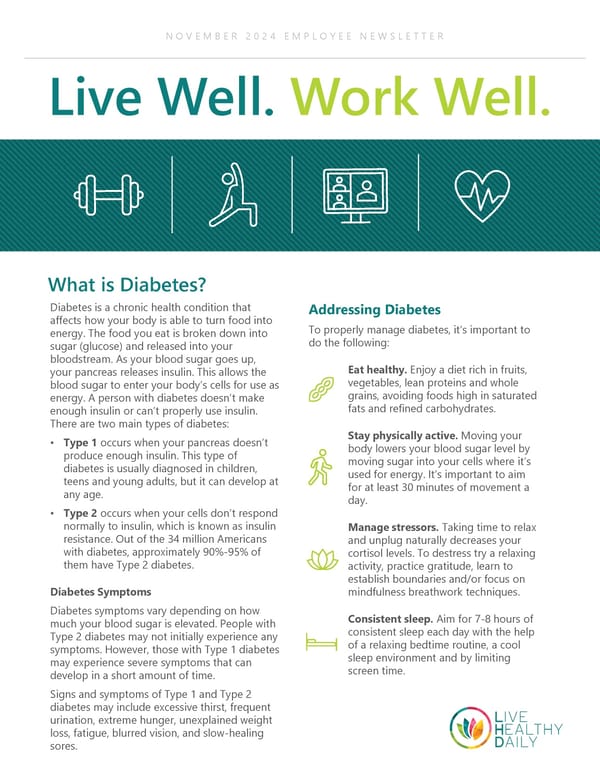Live Well. Work Well: Understanding and Managing Diabetes
The newsletter provides an overview of diabetes, its types, symptoms, and methods to manage it through lifestyle changes such as diet, physical activity, stress management, and good sleep.
NOVEMBER 2024 EMPLOYEE NEWSLETTER Live Well. Work Well. What is Diabetes? Diabetes is a chronic health condition that Addressing Diabetes affects how your body is able to turn food into To properly manage diabetes, it’s important to energy. The food you eat is broken down into do the following: sugar (glucose) and released into your bloodstream. As your blood sugar goes up, Eat healthy. Enjoy a diet rich in fruits, your pancreas releases insulin. This allows the vegetables, lean proteins and whole blood sugar to enter your body’s cells for use as grains, avoiding foods high in saturated energy. A person with diabetes doesn’t make fats and refined carbohydrates. enough insulin or can’t properly use insulin. There are two main types of diabetes: Stay physically active. Moving your • Type 1 occurs when your pancreas doesn’t body lowers your blood sugar level by produce enough insulin. This type of moving sugar into your cells where it’s diabetes is usually diagnosed in children, used for energy. It’s important to aim teens and young adults, but it can develop at for at least 30 minutes of movement a any age. day. • Type 2 occurs when your cells don’t respond normally to insulin, which is known as insulin Manage stressors. Taking time to relax resistance. Out of the 34 million Americans and unplug naturally decreases your with diabetes, approximately 90%-95% of cortisol levels. To destress try a relaxing them have Type 2 diabetes. activity, practice gratitude, learn to Diabetes Symptoms establish boundaries and/or focus on mindfulness breathwork techniques. Diabetes symptoms vary depending on how Consistent sleep. Aim for 7-8 hours of much your blood sugar is elevated. People with consistent sleep each day with the help Type 2 diabetes may not initially experience any of a relaxing bedtime routine, a cool symptoms. However, those with Type 1 diabetes sleep environment and by limiting may experience severe symptoms that can screen time. develop in a short amount of time. Signs and symptoms of Type 1 and Type 2 diabetes may include excessive thirst, frequent urination, extreme hunger, unexplained weight loss, fatigue, blurred vision, and slow-healing sores.
 Live Well. Work Well: Understanding and Managing Diabetes Page 2
Live Well. Work Well: Understanding and Managing Diabetes Page 2